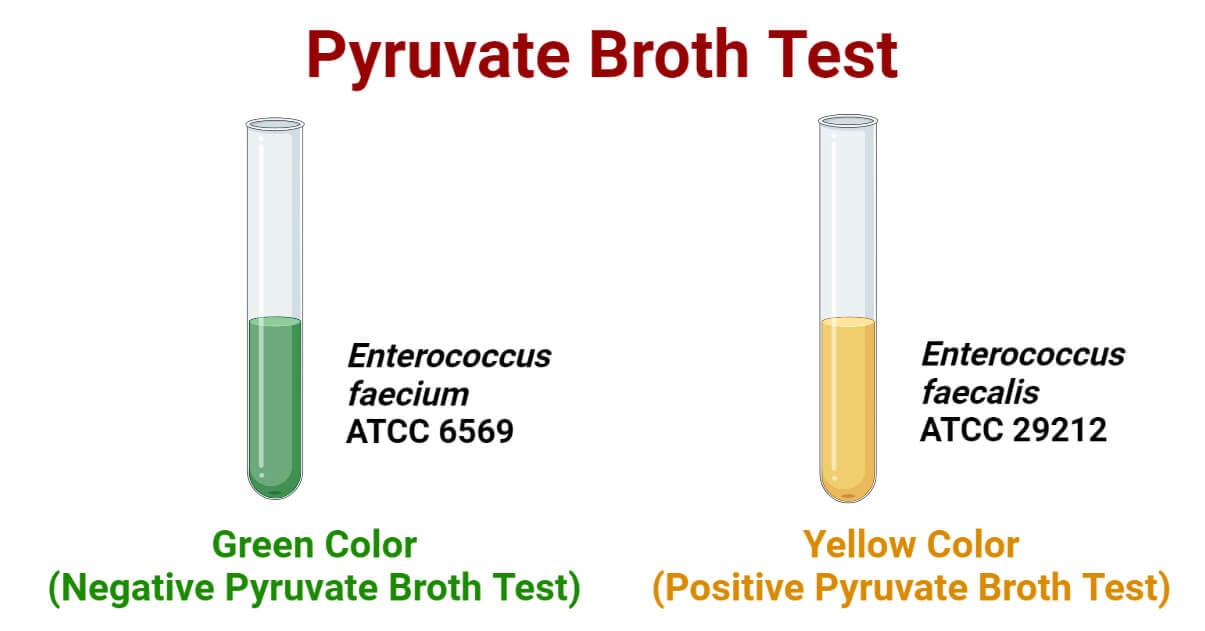Pyruvate Broth Test is the biochemical test used to assess the ability of bacteria to utilize pyruvate and produce metabolic acid. Two pyruvates are produced as end products during glycolysis (aerobic breakdown of glucose). Pyruvate is a conjugate base of pyruvic acid formed by deprotonation of the carboxy group of a pyruvic acid molecule. It is a 2-oxo-monocarboxylic acid anion. These pyruvates are fated to enter into different metabolic reactions and produce different products including metabolic acids, ethanol, or acetyl CoA.
Different bacteria metabolize pyruvate in different ways and produce different end products. This feature of bacteria is taken into account and a testing method is devised to distinguish bacteria having the capacity to ferment pyruvate and produce acid from those that can’t produce acid using pyruvate, called the pyruvate broth test. It is mainly used to distinguish Enterococcus spp.
In this test, a broth with low nutrition and no free carbohydrates is supplemented with pyruvate (sodium pyruvate). In absence of carbohydrates, bacteria don’t follow glycolysis; instead, they tend to metabolize pyruvate. The ability of a microorganism to metabolize carbohydrates and the resulting metabolic end product will determine the test results.
Interesting Science Videos
Objectives
- To assess the ability of bacteria to utilize pyruvate and produce metabolic acid.
- To aid in the differentiation of Enterococcus faecalis from Enterococcus faecium.
Principle of Pyruvate Broth Test
Some bacteria can utilize pyruvate and produce organic acids like lactic acid and oxaloacetic acid; whereas, some can’t utilize the pyruvate or don’t produce acid as the end product. If the bacteria are acid producers, the pH of the medium will drop, which can be detected by the bromothymol blue indicator in the medium. At acidic conditions, the color of the bromothymol blue changes from greenish-blue to yellow, making the whole medium yellow, and this color change indicates a positive result.
Requirements for Pyruvate Broth Test
Culture Medium
Pyruvate broth is used for this test. It is a low-nutrient culture medium without any added carbohydrates.
Composition of Pyruvate Broth per 1000 mL
Pancreatic Digest of Casein- 10.00 grams
Yeast Extract- 5.0 grams
Sodium Pyruvate- 10.0 grams
Sodium Chloride- 5.0 grams
Dipotassium Phosphate- 5.0 grams
Bromothymol Blue- 0.04 grams
Final pH 7.3 ±0.2 at 25°C
(References: Microsoft Word – TP99.doc (dalynn.com)
Preparation of Pyruvate Broth
- Measure the appropriate amount of pyruvate broth powder (or the media components) according to the manufacturer’s instruction (35.0 grams per 1000 mL for above) and add the mixture in a conical flask (or glass bottle) with 1000 mL water.
- Stir well using a magnetic stirrer or manually and heat to boiling so that all the components dissolve completely in water.
- Dispense 5 mL (or desired volume) of the broth in test tubes and loosely put on the cap or cotton plug.
- Autoclave the test tubes at 121°C and 15 lbs pressure for 15 minutes and let them cool to below 40 – 45°C before inoculation.
Reagents
No extra reagents are required.
Equipment
| Test tubes Incubator | Weighing Machine Autoclave | Bunsen burner | Inoculating loop |
PPE and other general laboratory materials
Test Organism (Sample Bacteria)
Positive Control: Enterococcus faecalis ATCC 29212
Negative Control: Enterococcus faecium ATCC 6569 or Streptococcus bovis ATCC 9809
Procedure of Pyruvate Broth Test
- Using a sterile inoculating loop, pick up well-isolated colonies of sample bacteria from fresh (18 to 24 hours old) culture (sample from blood agar medium is preferred) and inoculate the broth.
- Incubate the tubes aerobically for 24 hours at 35±2°C and observe for color change (yellow color formation).
- If no color change is observed, re-incubate the medium for the next 24 hours and observe for color change.
Result and Interpretation of Pyruvate Broth Test
- A positive result is indicated by the change of color of the broth from greenish to yellow.
- A negative result is indicated by no change in the color of the medium or slight yellowish-green color formation due to a weak reaction.

Quality Control
Enterococcus faecalis ATCC 29212 results in the development of yellow color in the medium within 24 hours of incubation in ambient conditions.
Enterococcus faecium ATCC 6569 will grow but the color of the medium won’t change even after 48 hours of incubation.
Precautions
- Make sure that the medium doesn’t contain free carbohydrates because the test organisms may ferment carbohydrates and produce acid which will give a false positive result.
- Don’t report negative until after 48 to 72 hours of incubation. Some strains may be slow growers and late fermenters.
- A slight color change to yellowish green should be reported as a negative result.
Applications of Pyruvate Broth Test
- Pyruvate Broth Test is used to identify Enterococcus faecalis (positive test) in clinical isolates and differentiate it from similar bacterial species, Enterococcus faecium (negative test).
Limitations of Pyruvate Broth Test
- Have a very limited application – suitable only for Enterococcus and Streptococcus spp.
- It doesn’t give complete identification and requires other biochemical test results to confirm the bacterial identity.
References
- Tille, P. M., & Forbes, B. A. (2014). Bailey & Scott’s diagnostic microbiology (Thirteenth edition.). St. Louis, Missouri: Elsevier.
- Microsoft Word – TP99.doc (dalynn.com)
- Lecture notes – The pyruvate broth test – The Pyruvate broth is a carbohydrate-free, – Studocu
- Pyruvate Broth Test – Principle, Procedure, Uses and Interpretation.docx – Pyruvate Broth Test – Principle, Procedure, Uses and Interpretation Last | Course Hero
- Pyruvate Broth Test: Principle, Procedure, and Result (researchtweet.com)
- Pyruvate Broth Test – Principle, Procedure, Uses and Interpretation (microbiologyinfo.com)
- Pyruvate Broth Test Principle, Purpose, Procedure, Result (microbiologynote.com)
